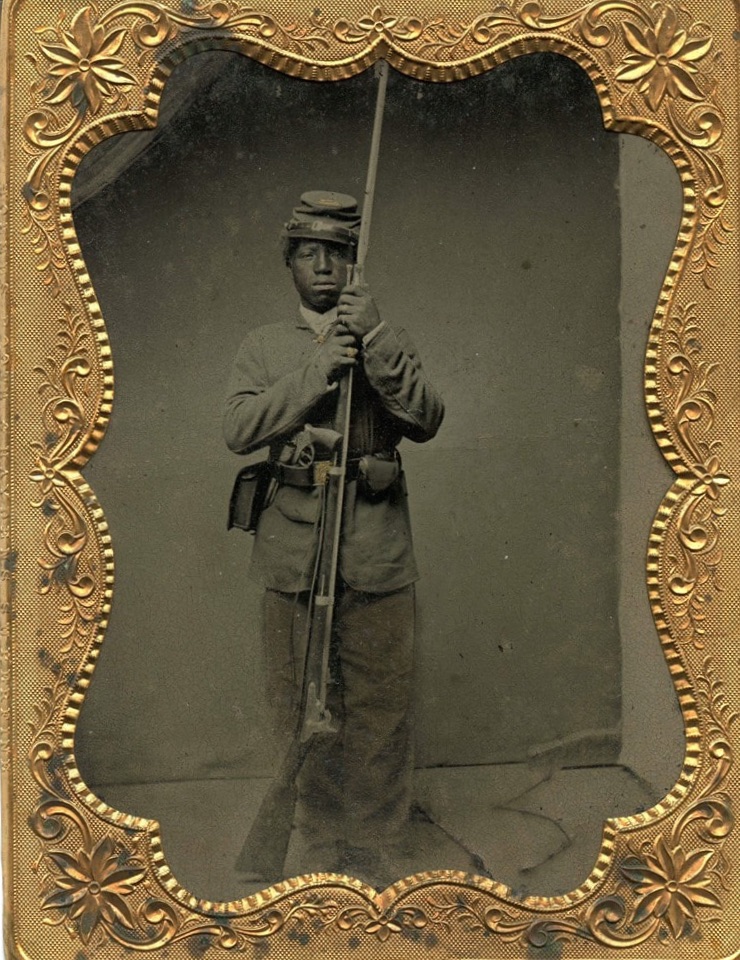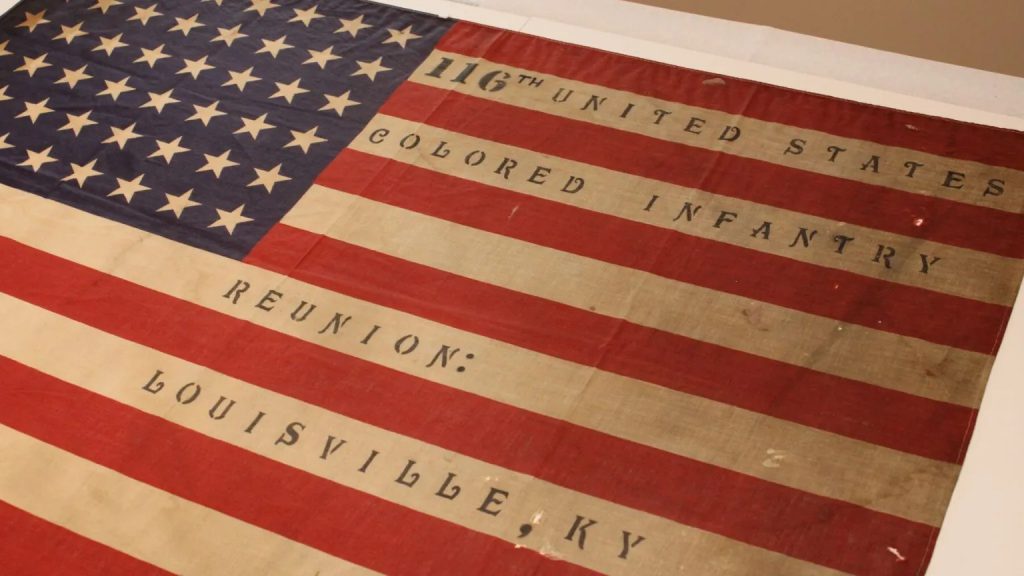To Prove Our Worth: The 116th USCT Infantry From Civil War Service to Modern-Day Preservation
“To Prove Our Worth”: The 116th U.S.C. Infantry From Civil War Service to Modern-Day Preservation

The 116th USCT (United States Colored Troops) Infantry, raised in 1864, not only served through the latter years of the Civil War but continued into the post‑war occupation period. Its story is one of battlefield duty and perseverance under hardship. Today, its memory lives on through the preservation of its reunion flag at Camp Nelson National Monument in Nicholasville, Kentucky.
Origins and Military Service Summary
Organization and Attachments
The 116th USCT was organized at Camp Nelson, Kentucky, between June 6 and July 12, 1864. Initially, it was attached to the Military District of Kentucky in the Department of the Ohio. Over time it was moved through various command structures: to the 10th Corps (Army of the James), the 1st Brigade, 2nd Division, XXV Corps, and finally assigned to the Department of Texas and the Department of the Gulf until its muster-out in January 1867.
Campaigns and Duties
After duty at Camp Nelson, the regiment joined defensive operations at Hickman’s Bridge during a Confederate attack. In September 1864, the 116th USCT moved east to report to General Butler’s forces at City Point, Virginia. From October 1864 to April 1865, the regiment participated in the Siege of Petersburg and Richmond, engaging in operations across the James River, trench work, and expeditions including Hatcher’s Run and the Appomattox Campaign. The 116th took part in the fall of Petersburg on April 2 and pursued Lee’s forces to Appomattox Court House.
After Lee’s surrender, the regiment remained in Virginia until May 25, when it embarked for Texas, arriving in June. There it undertook occupation and garrison duties, including in the Lower Rio Grande district, before moving to New Orleans. The regiment was finally mustered out in Louisville, Kentucky on January 17, 1867.
Formation, Training, and Early Challenges
Kireker recalled the early formation of the unit under many doubts:
“The organization of the regiment commenced under difficulties, with much doubt expressed as to the propriety and utility of raising still another colored regiment when so many were filling the ranks of the Union Army already.”
From a contemporary Christian Recorder article, one recruit was quoted as saying:
“I go so that none may say our people stood idle when freedom called.”
Kireker emphasized the expectations placed on the new soldiers:
“It was necessary to instruct not only in drill and discipline, but in the habits and confidence of soldiers who must bear in mind that all eyes were upon them.”
Training life was tough. The regiment suffered shortages of clothing and shoes, and pay was delayed:
“Shoes were wanting, clothing not furnished in time, and pay was often delayed without proper explanation.”
One private, writing in the New York Anglo-African, remarked:
“If they send us to the rear of the lines, we will drill until they see we belong at the front.”
Combat, Disease, and Tenacity
On campaign, the 116th USCT was engaged in sieges, trench work, and assaults. But disease, exposure, and the wear of constant duty claimed many. As Kireker wrote:
“Disease proved our most relentless foe. Men who were strong at muster found themselves laid low in strange places, with too little comfort and often no family to attend them.”
From a soldier’s pension affidavit:
“I fear the fever more than the rifle. There is no running from it.”
Kireker described moments of valor in skirmishes and defenses:
“Our men stood their ground with firmness, executing each command with exactness, to the notable satisfaction of the officers overseeing the post.”
He also recorded praise from higher command:
“They did not falter where others had done so. The bearing of the 116th was creditable to the service.”
Racial bias within the Union structure also tested the regiment. Kireker noted:
“Prejudice from certain quarters was not infrequent, whether in matters of supplies or the disposition of duties. Yet the men comported themselves with dignity, seeking no special favor.”
A white officer later wrote in a veterans’ circular:
“They knew they fought two battles—one in the field, and one in the minds of men who doubted them.”
In southern towns through which they marched, impressions shifted. One Christian Recorder field report observed:
“The colored troops moved with precision, their uniforms neat, their muskets shining. Citizens who had scoffed now looked on in silence.”
Within the unit, mutual support and a shared sense of mission bolstered morale. Kireker remarked:
“Among them was a spirit of mutual regard not always discovered in older organizations. The men seemed resolved to succeed together, not singly.”
A postwar county veterans’ history quoted a sergeant:
“What drove us was not only country, but the belief that our actions would speak for those who had no voice.”
Muster-Out and Legacy
As the war ended, the regiment’s final months involved demobilization and occupation duty. Kireker recorded the closing with dignity:
“The 116th, having answered the call of the nation, departs its post with honor. Whatever history shall say, these men have borne true witness to their valor and fidelity.”
A veteran, in pension testimony, reflected:
“I wore the blue so my children would not have to beg for the right to live free.”
Their name lists, promotions, casualties, and movements survive in Kireker’s roster, making the 116th one of the more thoroughly documented U.S.C.T. units.
The 116th USCT Reunion Flag: Preserving the Memory

Beyond the battlefield and muster rolls, the legacy of the 116th USCT lives in a humble, poignant artifact: the regiment’s reunion flag. The Stories Through Keepsakes article “Rolling up the Reunion Flag of a Civil War Regiment, the 116th U.S. Colored Troops” recounts how, decades after the war, descendants, veterans, and historians safeguarded a banner that symbolized remembrance and identity.
I highly recommend reading the Stories Through Keepsakes article as it is a brilliant example of how we as collectors and museums preserve and protect these important artifacts from our history. It is incredible to follow a regiment’s journey from its original formation all they way through to modern times with the preservation of that regiment’s reunion artifacts.
Sources
- Kireker, Charles. History of the 116th Regiment U.S.C. Infantry. New York: T. Holman, 1866.
- National Park Service, Civil War Soldiers and Sailors Database: 116th Regiment, United States Colored Troops.
- Pension records and affidavits of U.S.C.T. veterans, National Archives.
- Christian Recorder, 1864–1865.
- New York Anglo-African, 1864–1865.
- Officer accounts published in veterans’ circulars and postwar regimental notes, 1868–1880s.
- Stories Through Keepsakes, “Rolling up the Reunion Flag of a Civil War Regiment, the 116th U.S. Colored Troops.”

